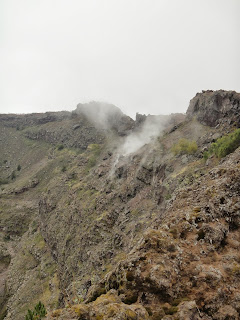Pompei
We had a smooth crossing to reach
Bari, Italy. It was Sunday when we
arrived and of course everything was closed. Mike bought a map at a garage and we were off
across to the other side of the country, firstly along the coast then inland
among the vineyards and olive groves.
The weather was definitely cooler for which we were grateful. Signs
everywhere pointing to historic churches, but we cannot visit them all, we were
headed to Pompei. We came to a small
village in a rural setting and were surprised to see wind turbines, hundreds of
them, in a valley, they usually sit up on the hillside and there was no wind,
all was calm. Next morning we knew why
the wind turbines were there, the wind swept through the valley at great
speed. We could only manage twenty eight
kilometres and stopped for the day, sheltering at an old homestead. At 6pm the wind just stopped, like someone
had turned off a switch. The next day
was calmer as we headed into the hills, climbing up and down for the next few days
passing through small villages until we reached Pompei. Along the
way we met a man whose parents were Italian but he was born in England. He
bought a holiday house in Italy which they used frequently and then his
children refused to go home and have settled here so now he does too. He spoke
of the frustration of trying to get business done, he uses the internet
whenever possible. We sympathized, we
wanted to post some postcards and after much searching found “la posta”. The man weighed each card, looked
up individually the cost and attached the stamp. What could have been a two minute
transaction took ten.
Every garage has a bar – a coffee
bar. Every town has a pizzeria or two or three. We have eaten a lot of pizza
but not succumbed to the short black yet. Pastry for breakfast, pizza for
lunch, spaghetti bolognaise for dinner, Mike will put that weight he has lost
back on in no time.
Mike had his second puncture for
the trip, the last one was in Vietnam.
That makes two each, all of them from wire off retreads along the road.
The last thirty kilometres into
Pompei was a traffic bottleneck and it was late when we arrived. Unfortunately Mike has a mild return of
vertigo, but medication which we had brought with us and a few days rest did
the trick and we were able to visit the Pompei ruins, go to the crater of Mt.
Vesuvius and take a trip along the Amalfi coast to Sorrento.
Pompei is an ancient city buried
by a volvano eruption on 24th August, 79 AD and has been excavated
to reveal a whole city. As we walked down the street, we could see where cart
wheels has worn down the stones through constant use, the remains of bakeries
and wine shops and everyday houses and shops.
There were also religious sites for worshipping Gods and Godesses, Christianity
had not made it here. There is a large theatre and a smaller one, an odium, and
an amphitheatre. It is a skeleton of a
city which stands as it was built with walls and fountains frozen in time. The
area is large, forty four acres, and it took us all day to get around it all.
The next day we went to Mt Vesuvius. The
crater which caused all the damage to Pompei is dormant and can be seen
surrounded by lava, now solidified. There is another crater, still active,
which we were able to peer into. Steam can be seen rising from the cracks in the
walls. From the crater the view is
extensive across to Naples, the ocean and the Isle of Capri.
We caught a bus along the Amalfi
coast to Sorrento. This area is impressive with houses perched on cliffs and
vineyards on terraces as we wound along a narrow, busy road of hairpin bends. The
townships of Amalfi and Sorrento were crowded so we could only imagine what it
would be like in the busy tourist season.
We have been in Pompei for a week,
The weather has been glorious, about twentyfive degrees every day, and we have
met some interesting people at the camping ground. A number of Australians and Kiwis and the
always friendly Germans who speak perfect English. Byron from Tasmania who is touring with a mobile home gave us a flag with a kangaroo on it and it now adorns Heather's pannier, just to let people know where we are from. Byron carries spare flags just to give away. It is time be on the bikes
again and we will be heading to Naples, then Rome.





















































